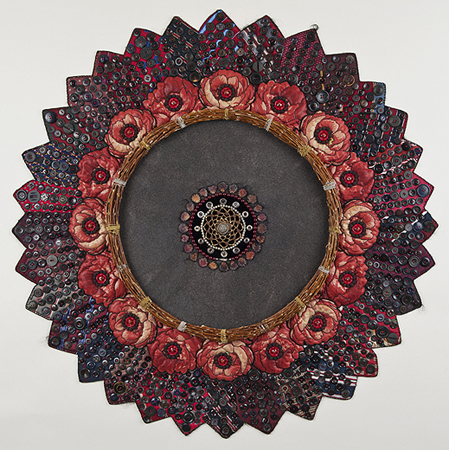Donna Sharrett
Ossining,
USA
Donna Sharrett was born in Philadelphia. She earned a BFA degree from the School of Visual Arts, New York, and is a recipient of two New York Foundation for the Arts Artist Fellowships and several residency and grant awards. Her work has been exhibited at numerous venues including the U.S. Embassy, Bangladesh; the Bronx Museum of the Arts, New York; the Katonah Museum of Art, Katonah, NY; the John Michael Kohler Institute, Sheboygan, WI; and, in a solo exhibition at the Everson Museum in Syracuse, NY.
Articles about her work have appeared in the New York Times, Art & Antiques, Fiberarts, Sculpture, Surface Design and Woman’s Art Journal. Exhibitions of her work have been reviewed in BT (Tokyo), Frankfurter Allgemeine Zeitung (Germany), the New York Times, Time Out New York, the Village Voice and other publications. Her work can be found in numerous private collections including that of the U.S. Embassy in Valletta, Malta; and in such public collections as that of the Museum of Arts and Design, New York. Donna Sharrett is represented by Pavel Zoubok Gallery, New York.
Feminist Artist Statement
Informed by research into cultural and religious traditions of memorial and remembrance, my works celebrate women’s roles as archivists, teachers, caretakers of personal histories and preservers of traditions. Traditional needlework techniques are used to create the works including crochet, embroidery and needlelace.
During my mother’s illness with terminal cancer in 1989, needlework bridged the silence that occurred when the enormity of the situation made ordinary conversations meaningless. In a need to communicate and to maintain some semblance of the normal hierarchy within a mother/daughter relationship, I retrieved my mother’s unfinished needlework projects for her to reteach me the stitches I learned as a child. We were rejoining that venerable needlework sorority where knowledge of stitches and patterns are taught in intimate gatherings. Needlework processes and materials began to define my work in the late 1990’s.
I consider my works to be repositories for keepsakes, and custodians of memories. Gifts and discoveries of family heirlooms such as handmade doll’s clothes, jewelry and buttons join the repertoire of materials symbolic of memory or memorial such as dirt, roses and hair, which have continued to inform my work. Guitar-strings are used as a dedication to my brother Scot Sharrett (1961-2001), as are song titles chosen to name the works. His collection of hundreds of guitar-string ball-ends inspired my ‘Arrangements’ series.
The works remain meditations on the beauty of rituals developed over time to satisfy the fundamental human need to mark important passages in life. Nineteenth century memento mori hair jewelry, contemporary floral makeshift shrines, prayer beads, wedding rings, quilts and Buddhist mandalas are referenced. Geometric schemes of Gothic cathedral rose windows and the numeric configurations of religious prayer beads often inform the work.
Some notes about my materials:
Since 2001 dirt has been used as a material for the biblical reference, “for dust thou art, and unto dust shalt thou return,” in response to the World Trade Center recovery effort that occurred while I sorted through my brother’s belongings following his death on September 2, 2001.
Handmade rose beads are created, inspired by a 13th century recipe for rosary beads made by German Nuns.
Buttonhole stitches are used in the works in honor of my mother who would say, “the sign of a well-made garment is handmade buttonholes. Thread from American & Efird Mills in Mt. Holly, NC where she worked is used in the works.

Fire and Rain
Websites
Contact
EmailCV
PDF DowloadText, images, audio, and/or video in the Feminist Art Base are copyrighted by the contributing artists unless otherwise noted. All rights reserved.






